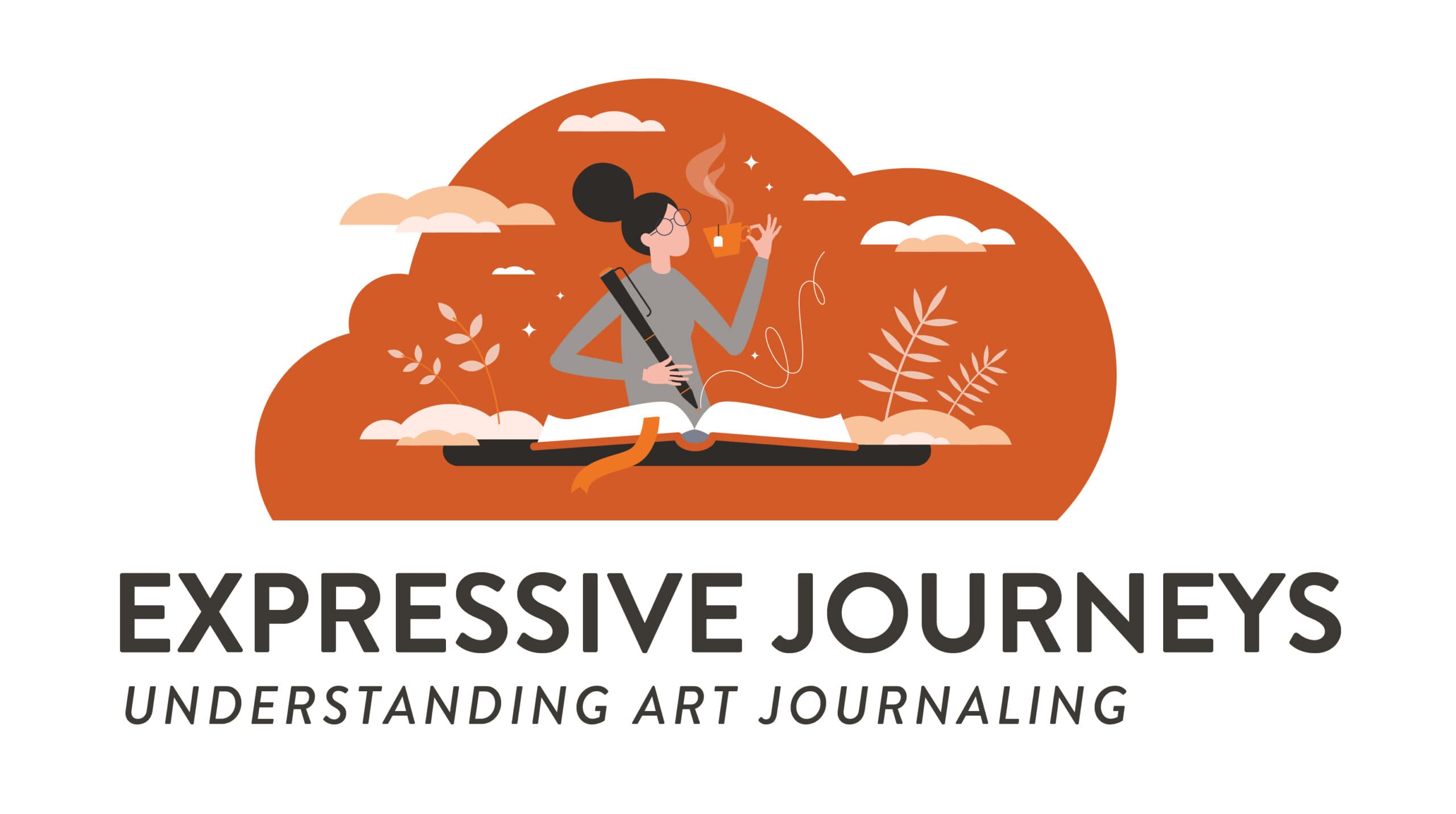Art journaling is a creative form of self-care that combines the elements of art and journaling into a visual diary, offering a unique way for individuals to express themselves. Art Journaling involves an individual blend of imagery and text, with no wrong way to approach it. This practice not only enhances creativity and mindfulness, but also supports personal growth and emotional resilience, making it a powerful tool for self-expression and discovery.
What is Art Journaling?
An art journal is a visual diary that serves as a creative form of self-care, blending the practice of making art with self-expression. Unlike a traditional written journal, it incorporates colors, images, patterns, and various materials. Some art journals contain extensive writing, while others are primarily filled with images. Nikki Jouppe, an artist and teacher of Intro to Art Journaling, describes it as a “mashup of art and journaling,” where the balance between art and written content varies from one individual to another. According to Jouppe, there is no wrong way to maintain an art journal; engaging in this activity in any form is doing it right.
Benefits of Art Journaling
Art journaling offers a wide array of benefits, making it an invaluable practice for individuals looking to explore creative expression and foster personal growth. As a therapeutic activity, it provides a unique outlet for emotions, offering a safe and personal space to explore and release feelings through both visual and written forms. This act of expression can significantly enhance mindfulness and reduce stress, as it encourages individuals to focus on the present moment while engaging in the creative process. Furthermore, art journaling promotes creativity and innovation, allowing for the freedom to experiment with diverse materials and artistic techniques without fear of judgment. It also serves to boost self-esteem and confidence, as individuals gain a sense of accomplishment from creating and completing artistic projects. Additionally, art journaling can improve problem-solving skills and encourage a deeper connection with one’s thoughts and feelings. Overall, art journaling is not merely a form of self-care; it is a powerful tool for personal development, emotional resilience, and self-discovery.
Getting Started with Art Journaling
Starting an art journal invites a blend of creativity and personal exploration. Whether you’re a seasoned artist or a curious beginner, starting an art journal is a fulfilling way to document your artistic voyage and express your innermost thoughts. Here’s how to begin your own unique journal, tailored to your creative needs and aspirations.
Choosing the Right Sketchbook
Starting an art journal begins with selecting the right sketchbook, which is the foundation of your creative journey. The size of the sketchbook is a crucial consideration; it should be large enough to provide ample space for your artwork but portable enough to carry around easily. Common sizes include A4 for larger works and A5 for a more compact option.
Materials to Use
The materials you utilize will significantly shape your art journaling experience. Beginners may wish to start with essentials such as pencils, pens, watercolors, and acrylic paints. As you grow more confident in your skills, expanding your arsenal to include markers, pastels, inks, and various collage materials like magazine clippings, fabric scraps, and ephemera can enrich your pages.
Type of Paper
The paper in your sketchbook must be compatible with the mediums you intend to use. For artists planning to use mixed media, opt for a sketchbook that features thick, heavyweight paper to adequately support wet media like watercolors and acrylics without buckling. Lighter paper can suffice for primarily dry media applications.
Kind of Binding
The sketchbook binding is crucial as it influences how flat the sketchbook can lay when open, which impacts usability. Spiral-bound sketchbooks are excellent for laying completely flat or folding over, making them extremely practical for active use. Spiral-bound sketchbooks are useful when wanting to take out pages. Alternatively, hardbound sketchbooks offer greater durability and protection, although they may not lay as flat.
With your materials and sketchbook ready, dive into creating. Art journaling is unique in that it imposes no stringent rules—each page is a new opportunity for your thoughts, experiments, and personal expression. Whether you begin with simple sketches, bold paints, or intricate collages, the most important aspect is to relish the creative process and allow your artistic impulses to guide you.
Techniques in Art Journaling
Art journaling offers a vast array of techniques that allow for personal expression and experimentation. Here are some popular methods that can help you unleash your creativity within the pages of your art journal:
Mixed Media
Mixed media in art journaling involves combining various art forms and materials on a single page. This technique may include elements like painting, drawing, collage, and digital prints. The beauty of mixed media lies in its limitless possibilities and the unique outcomes that emerge from layering different textures and media.
Layering
Layering is a technique used to add depth and interest to art journal pages. It involves overlapping multiple materials and elements, such as papers, tags, fabric, and ephemera. Each layer contributes to the complexity of the design, creating rich, textured compositions that tell a visual story.
Stenciling and Stamping
Stenciling and stamping provide a way to add consistent patterns or imagery to your journal. Stencils can be used with inks, paints, or pastes to create crisp, repeated designs, while stamps can be employed for adding text or decorative motifs. Both techniques are excellent for beginners and seasoned artists alike, offering a quick and easy way to embellish your pages.
Writing and Doodling
Incorporating writing and doodling into your art journal turns the page into a canvas for your thoughts and spontaneous sketches. This approach not only decorates your journal but also personalizes it, allowing you to capture fleeting ideas, emotions, and narratives in a visual format.
Watercoloring
Watercoloring is a beloved technique for its fluidity and vibrant hues. It allows for the creation of soft backgrounds or detailed scenes within your art journal. The translucency of watercolors is ideal for layering colors and creating gradient effects, making it perfect for evocative, atmospheric pages.
Each of these techniques can be used individually or combined to create dynamic and visually captivating art journal pages. The key is to experiment and find what resonates with your artistic style and expression.
Creative Prompts and Ideas
Art journaling thrives on creativity and personal expression, and sometimes all it takes to get started is a simple prompt or an inspiring idea. Here are several prompts and ideas to help spark your imagination and fill your art journal pages with meaningful content:
- Mood Tracker
Create a mood tracker using colors, shapes, or images to represent different emotions you experience over a month. This can be a visual reflection of your emotional landscape, helping you identify patterns or triggers.
- Dream Diary
Dedicate a section of your art journal to interpreting and illustrating your dreams. Use surrealistic or abstract techniques to convey the often elusive and symbolic nature of dreams.
- Seasonal Inspiration
Reflect the changing seasons with pages that capture the colors, textures, and feelings of spring, summer, autumn, and winter. Incorporate natural elements, seasonal quotes, or holiday memories specific to each time of the year.
- Favorite Quotes
Create art pages around your favorite quotes. Use lettering techniques to make the quotes visually striking, and decorate the surrounding space with illustrations that enhance or contrast the theme of the quote.
- Music and Lyrics
Let your favorite songs inspire your artwork. Illustrate scenes or emotions that the music evokes, or experiment with visualizing the lyrics in unique and personal ways.
- Self-Portrait
Challenge yourself with a self-portrait that captures more than just your appearance. Include symbols or elements that represent your personality, interests, and dreams.
- Gratitude Page
Maintain a gratitude section where you visually express things you’re thankful for. This can be a recurring theme, where you add something new each week or month.
- Travel Memories
Dedicate pages to past travels or dream destinations. Use maps, photos, and souvenirs to create a visual travel diary that reflects your experiences or aspirations.
- Experimental Techniques
Set aside pages to experiment with new art materials or techniques you haven’t tried before. This could involve mixing media, playing with textures, or practicing different art styles.
These prompts are just starting points. Each page of your art journal is a canvas for your thoughts, feelings, and creativity, and the possibilities are as limitless as your imagination.
Sharing and Community
Art journaling can transcend beyond personal journals and into vibrant online communities and local groups. Platforms like Instagram and Pinterest, along with dedicated art forums, allow artists to showcase their work, discover new inspiration, and connect globally using specific hashtags. Additionally, joining art journaling groups or attending workshops can offer opportunities to learn new techniques, receive feedback, and participate in journaling challenges or collaborative projects.
Engaging in art swaps or mail art can introduce interactive elements to your practice, connecting you with artists worldwide and enriching your perspective. For those who enjoy teaching and sharing, creating tutorials or blogging about your art journaling experiences can further integrate you into the community, helping others while documenting your artistic growth. This communal interaction not only enhances your creative journey but also contributes to a supportive network that values artistic expression and personal growth.
Overcoming Common Challenges
Art journaling, while rewarding, often presents challenges such as the fear of the blank page and perfectionism. To overcome these, start with light background colors or textures to make the page less intimidating and remember that the goal is expression, not perfection. Techniques like setting time limits or engaging in continuous line drawing can help curb meticulous tendencies and foster spontaneity.
Creative blocks and time constraints are other common hurdles. Draw inspiration from your surroundings or use community challenges to reignite creativity. If time is scarce, try scheduling brief, consistent sessions; even a few minutes daily can lead to progress. Avoid overthinking and allow your instincts to guide your creations. Remember, you don’t need expensive materials—everyday items can also yield innovative and personal artwork. Embracing these strategies can make your art journaling more enjoyable and fulfilling.
Art journaling is more than just a creative pastime; it’s a profound means of self-exploration and expression that can impact all areas of one’s life. Whether you’re a beginner or an experienced artist, each page of an art journal offers a new opportunity to reflect, grow, and connect with a vibrant community of like-minded creatives. Embrace this artistic journey and discover the transformative power of putting pen, paint, and passion to paper.
Interested in transitioning from art journaling to a professional art career?
Start applying your skills and creativity by exploring the online and on-campus degree programs at RMCAD today.

